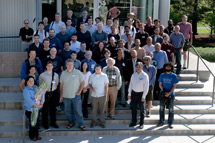
Handy Links
SLAC News Center
SLAC Today
- Subscribe
- Archives: Feb 2006-May 20, 2011
- Archives: May 23, 2011 and later
- Submit Feedback or Story Ideas
- About SLAC Today
SLAC News
Lab News
- Interactions
- Lightsources.org
- ILC NewsLine
- Int'l Science Grid This Week
- Fermilab Today
- Berkeley Lab News
- @brookhaven TODAY
- DOE Pulse
- CERN Courier
- DESY inForm
- US / LHC
SLAC Links
- Emergency
- Safety
- Policy Repository
- Site Entry Form

- Site Maps
- M & O Review
- Computing Status & Calendar
- SLAC Colloquium
- SLACspeak
- SLACspace
- SLAC Logo
- Café Menu
- Flea Market
- Web E-mail
- Marguerite Shuttle
- Discount Commuter Passes
-
Award Reporting Form
- SPIRES
- SciDoc
- Activity Groups
- Library
Stanford
Around the Bay
Workshop Shines a Light into Darkness
It was standing room only in SLAC's Redwood Conference Room Thursday morning, with physicists and astrophysicists from around the world convening for the first presentations of the Dark Forces Workshop, organized jointly by the SLAC Theory Group and BaBar Collaboration. The workshop, which ran September 24–26, drew more than 80 physicists to SLAC.
Recently, there has been much interest in models of dark matter in which these particles interact via new forces that couple very weakly to ordinary matter. Some researchers think these "dark forces" might be due to new particles with low masses, accessible to experiments at SLAC and other accelerators. The workshop reported on searches for these particles and discussed plans for new experiments.
"We want to bring scientists and experimentalists together to stimulate progress in searching for dark forces," said SLAC physicist Rouven Essig, who was one of the workshop organizers. It's a hot subject. Researchers have been poring over the recent glut of data provided by experiments like the Fermi Gamma-ray Space Telescope and PAMELA, and they've been finding some unexpected signals along the way.
"The biggest theme that has motivated us to start thinking about dark forces is that a real era of data has begun with regard to physics beyond the standard model," New York University physicist Neal Weiner said during the first presentation of the workshop. "We have simultaneously entered an era of anomalies." The new data have brought up plenty of new questions, presenting researchers with regions surprisingly rich in electrons and positrons.
One hypothesis is that these anomalies could be coming from dark matter interacting via a dark force. With this possibility in mind, scientists are now searching for dark force particles produced at accelerators. At the workshop, new searches for the dark particles were presented from many sources, including the electron-positron collider experiments BaBar, BELLE, BES-III, and KLOE, the Fermilab collider experiments CDF and D0, and experiments at the Jefferson Laboratory. Discussions focused on possible new searches for dark effects, looking at the facilities and techniques that could be the most useful. The workshop included plenary sessions at the Redwood Conference Room, along with smaller working group meetings to zero in on opportunities in the electron-positron data, at hadron colliders and in high-rate fixed target experiments.
The workshop ended Saturday afternoon with a summary of the conclusions reached by the working groups.
—Nicholas Bock
SLAC Today, September 28, 2009
